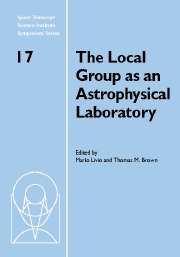 The Local Group as an Astrophysical Laboratory
The Local Group as an Astrophysical Laboratory Published online by Cambridge University Press: 12 May 2010
There is increasing observational evidence that hot, highly ionized interstellar and intergalactic gas plays a significant role in the evolution of galaxies in the local universe. The primary spectral diagnostics of the warm-hot interstellar/intergalactic medium are ultraviolet and X-ray absorption lines of O VI and O VII. In this paper, I summarize some of the recent highlights of spectroscopic studies of hot gas in the Local Group and low-redshift universe. These highlights include investigations of the baryonic content of low-z Ovi absorbers, evidence for a hot Galactic corona or Local Group medium, and the discovery of a highly ionized high velocity cloud system around the Milky Way.
Introduction
We live in a wonderful age of discovery and exploration of the universe. As we peer farther and farther back in time, it is becoming ever more important to make sure that we observe the local universe as well as possible. Observations of galactic systems and the intergalactic medium (IGM) in the low-redshift universe are required to study the universe as it has evolved over the last ∼5 billion years. They are essential for the interpretation of higher redshift systems, and they form a framework for studies of such key topics as galactic evolution, “missing mass,” and the distribution of dark matter. Studies of hot gas and its relationship to galaxies are shedding new light on these and other astronomical topics of interest today. In this review, I summarize some basic information about the elemental species and types of observations that can be used to study hot gas.
To save this book to your Kindle, first ensure [email protected] is added to your Approved Personal Document E-mail List under your Personal Document Settings on the Manage Your Content and Devices page of your Amazon account. Then enter the ‘name’ part of your Kindle email address below. Find out more about saving to your Kindle.
Note you can select to save to either the @free.kindle.com or @kindle.com variations. ‘@free.kindle.com’ emails are free but can only be saved to your device when it is connected to wi-fi. ‘@kindle.com’ emails can be delivered even when you are not connected to wi-fi, but note that service fees apply.
Find out more about the Kindle Personal Document Service.
To save content items to your account, please confirm that you agree to abide by our usage policies. If this is the first time you use this feature, you will be asked to authorise Cambridge Core to connect with your account. Find out more about saving content to Dropbox.
To save content items to your account, please confirm that you agree to abide by our usage policies. If this is the first time you use this feature, you will be asked to authorise Cambridge Core to connect with your account. Find out more about saving content to Google Drive.